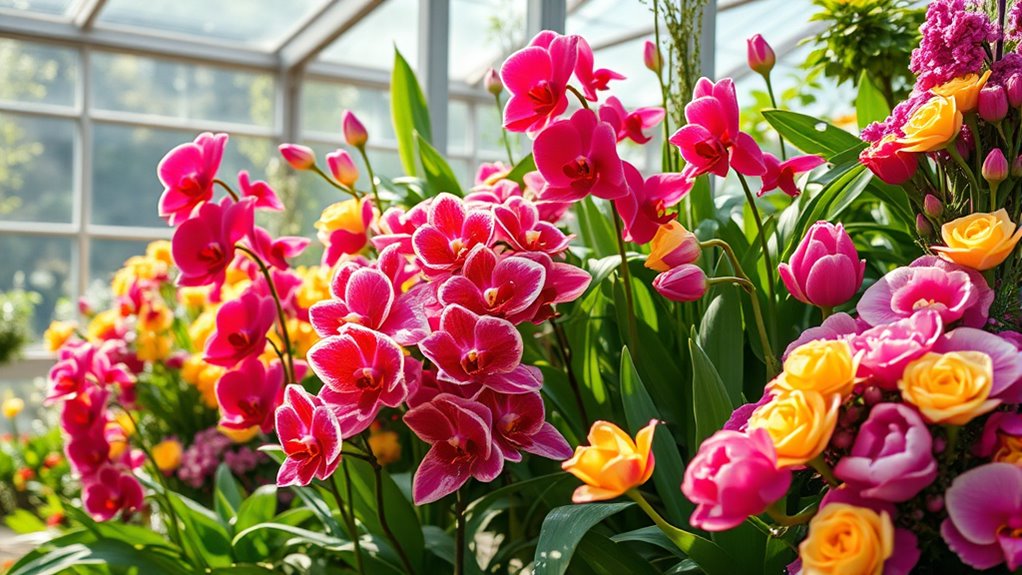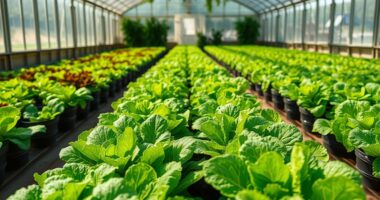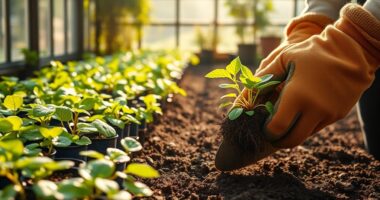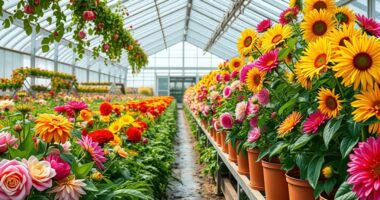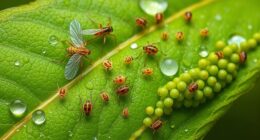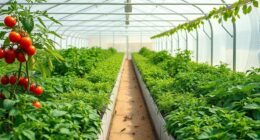To get vibrant, long-lasting blooms in your greenhouse, choose compatible flowering plants suited to your setup and guarantee proper soil with drainage. Optimize temperature and humidity—keep humidity around 60-70%—and provide adequate light. Regular fertilizing, pruning, and deadheading encourage continuous flowering. Manage pests and diseases early, and adjust environmental controls seasonally. Mastering these tips helps your plants thrive and produce more blossoms—keep exploring for all the secret ingredients to lush, colorful blooms.
Key Takeaways
- Prepare well-draining, nutrient-rich soil tailored to each plant’s needs to promote healthy root development and vibrant blooms.
- Maintain optimal temperature (70-75°F) and humidity (60-70%) with monitoring tools for consistent flowering conditions.
- Regularly prune, deadhead, and support pollination to encourage continuous blooming and prevent plant overcrowding.
- Use balanced fertilization schedules: high nitrogen for foliage, phosphorus-rich for flowers, applied every 1-2 weeks.
- Plan plant layout to maximize space, avoid shading, and adjust lighting and environmental controls seasonally for extended blooms.
Selecting the Right Flowering Plants for Your Greenhouse
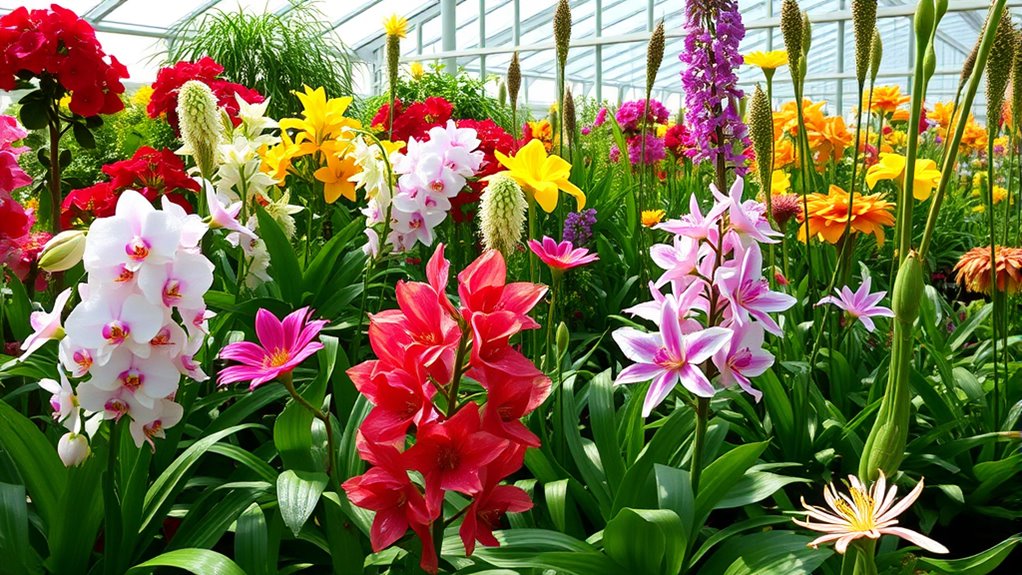
Choosing the right flowering plants for your greenhouse is essential to guarantee a thriving and beautiful display. Start with soil preparation by ensuring your soil has proper drainage, nutrients, and pH balance suited to your chosen plants. Healthy soil supports robust growth and vibrant blooms. Additionally, selecting plants that are compatible with your greenhouse’s electric conversion kit can help optimize your setup and maintenance. Consider your greenhouse layout when selecting plants; taller varieties should be placed where they won’t shade shorter ones, and space should allow for air circulation. Some plants thrive in specific light and space conditions, so match their needs to your greenhouse’s environment. Think about seasonal blooming times and maintenance requirements to keep your display colorful year-round. Proper soil preparation and thoughtful layout planning will give your flowering plants the best chance to flourish, creating a stunning greenhouse showcase. Incorporating space utilization strategies can further enhance your greenhouse’s productivity and overall aesthetic, especially in maximizing plant health and minimizing disease risks.
Optimizing Temperature and Humidity Conditions
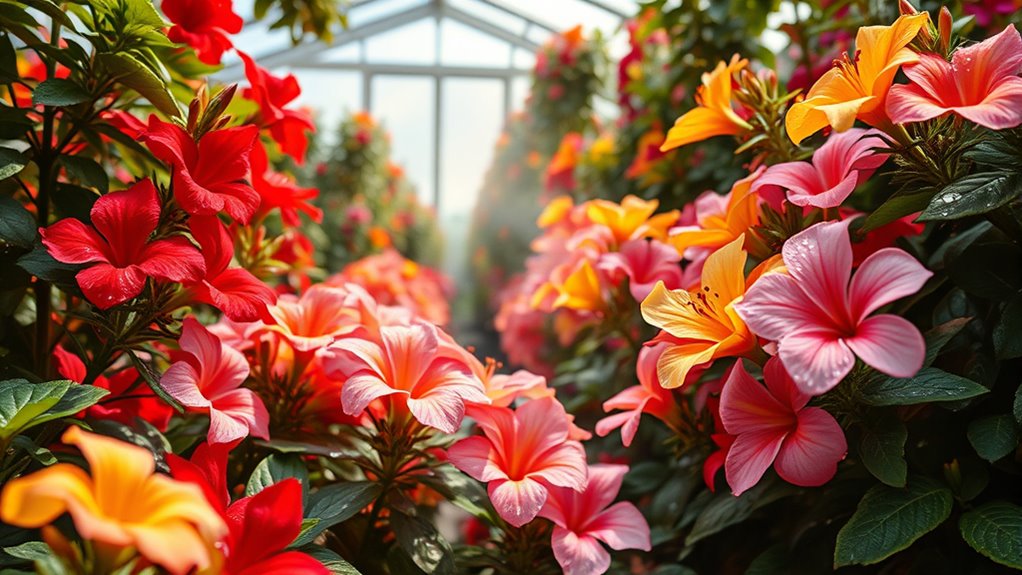
To keep your flowering plants healthy, you need to maintain temperature and humidity within ideal ranges. Using humidifiers effectively can help prevent issues caused by dry air, while monitoring environmental changes guarantees essential conditions. Consistently adjusting these factors will promote vibrant blooms and plant vitality. Employing proper environmental control techniques is crucial for creating optimal growing conditions in your greenhouse. Regularly observing climate fluctuations ensures that your plants remain in their preferred environment.
Maintaining Ideal Ranges
Have you ever wondered how precise control of temperature and humidity can make or break the health of your greenhouse plants? Maintaining ideal ranges requires more than just setting the thermostat; you need to monitor soil pH management and guarantee proper ventilation techniques.
Consistent temperature helps plants develop strong blooms, while controlling humidity prevents diseases. Use ventilation to regulate airflow, reducing excess moisture and stabilizing conditions.
Keep an eye on soil pH, as imbalances can hinder nutrient uptake, affecting flowering quality. Proper soil and air management create a stable environment, allowing plants to thrive.
Regularly adjust ventilation and monitor soil conditions to maintain the ideal ranges, ensuring your greenhouse plants produce vibrant, healthy blooms.
Using Humidifiers Effectively
Proper ventilation and soil pH management help maintain stable greenhouse conditions, but humidifiers take your environment a step further by fine-tuning humidity levels. To use a humidifier effectively, focus on proper humidifier placement—avoid placing it directly on plants or near vents to prevent uneven moisture distribution. Instead, position it where airflow can evenly disperse humidity throughout the space. Aim to keep humidity levels between 60-70% for most flowering plants, adjusting based on specific species’ needs. Regularly monitor humidity to prevent issues like mold or dehydration. Additionally, understanding optimal angles for pinball machines can help you create a more engaging and successful greenhouse environment by applying principles of balance and positioning to your equipment. Using a humidifier properly ensures your plants receive consistent moisture, promoting healthy blooms and vibrant growth. Proper humidity control can also prevent plant stress, ensuring your flowering plants thrive and produce vibrant blooms throughout their growth cycle. Incorporating environmental monitoring tools can further enhance your ability to maintain ideal conditions for your plants.
Monitoring Environmental Changes
Monitoring environmental changes is essential for maintaining ideal conditions in your greenhouse. Regularly check and calibrate sensors to ensure accurate readings of temperature and humidity. Proper sensor calibration helps you make informed decisions about your environment. Using high-quality air quality sensors can improve the accuracy of your monitoring efforts. To optimize airflow regulation, adjust vents and fans to prevent hot spots and stagnant air, which can harm your plants. Here are four key tips:
- Calibrate sensors monthly to maintain accuracy.
- Use precise airflow regulation to balance temperature and humidity.
- Track environmental data consistently for trends.
- Adjust heating or cooling systems based on sensor feedback. Additionally, understanding industry trends can help you stay ahead in greenhouse management and implement the latest best practices. Incorporating smart control systems can further enhance environmental stability and optimize plant growth conditions. Staying informed about technological advancements can lead to more efficient and effective greenhouse management strategies.
Providing Adequate Light for Bloom Development
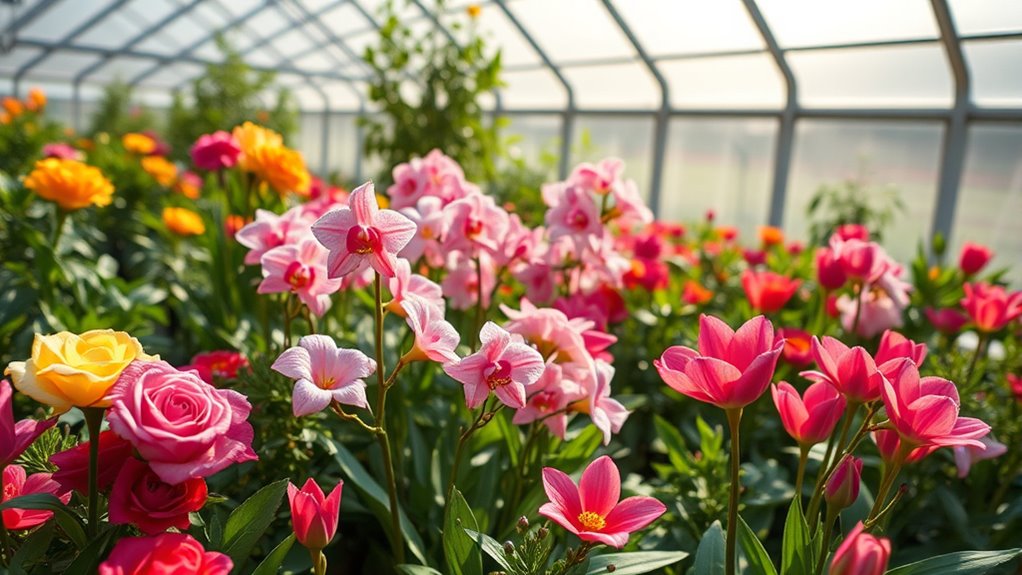
Providing enough light is essential for encouraging healthy bloom development in greenhouse plants. Ensuring they receive the right amount of sunlight requirements is key. During winter or low-light months, supplement with artificial lighting to maintain ideal growth. The type of light and duration depend on your plants’ needs. Use the following guide to understand light options:
| Light Type | Intensity | Best For |
|---|---|---|
| Natural sunlight | Bright, indirect sunlight | Most flowering plants |
| Fluorescent lights | Moderate intensity | Early growth, smaller blooms |
| LED grow lights | Adjustable, energy-efficient | Precise control over bloom timing |
| High-pressure sodium | High intensity, long-lasting | Large-scale flowering production |
Adjust lighting based on plant response to promote vibrant blooms. Proper lighting control can significantly influence flowering success.
Ensuring Proper Watering and Drainage Practices
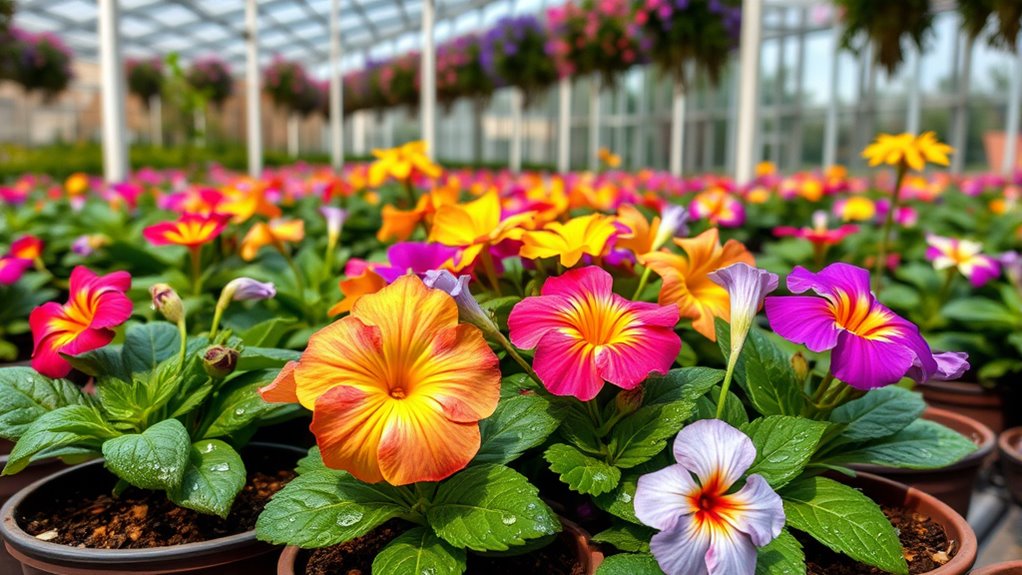
To keep your greenhouse plants healthy and thriving, you need to guarantee they receive the right amount of water and have proper drainage. Start by understanding your soil composition; well-draining soil prevents waterlogging and root rot. Adjust your watering frequency based on plant needs and environmental conditions—overwatering can harm roots, while underwatering stresses plants. Additionally, consider how automation technologies can assist in monitoring soil moisture levels to optimize watering schedules. Incorporating essential oils with antimicrobial properties can also support plant health by preventing certain fungal infections. Here are some tips:
- Check soil moisture with your finger; water only when the top inch feels dry.
- Use containers with drainage holes to prevent excess water accumulation.
- Incorporate organic matter to improve soil structure and drainage.
- Monitor weather and adjust watering schedules accordingly, especially during hot or humid days.
- Understanding soil composition helps in selecting the right watering practices and soil amendments for optimal plant health. Proper soil drainage is essential to avoid waterlogging and ensure healthy root development. Additionally, selecting appropriate soil mixes can further enhance drainage and plant growth.
Consistent watering practices paired with proper soil setup promote healthy blooms and vigorous growth.
Fertilizing for Vibrant Blooms and Healthy Growth

Fertilizing plays a crucial role in achieving vibrant blooms and robust growth in your greenhouse plants. Proper soil nutrient balancing ensures plants get essential elements like nitrogen, phosphorus, and potassium. To optimize results, follow a consistent fertilizer application schedule tailored to each plant’s needs. Use the table below to help plan your fertilizing routine:
| Plant Type | Fertilizer Type | Frequency |
|---|---|---|
| Flowering | Balanced liquid fertilizer | Every 1-2 weeks |
| Foliage | High nitrogen fertilizer | Monthly |
| Blooming | Phosphorus-rich fertilizer | Biweekly |
Stick to these guidelines, monitor plant responses, and adjust your schedule as needed for lush, vibrant blooms and healthy growth. Regular fertilization supports overall plant health, which is vital for healthy indoor environments and optimal flowering.
Controlling Pests and Diseases in Your Greenhouse
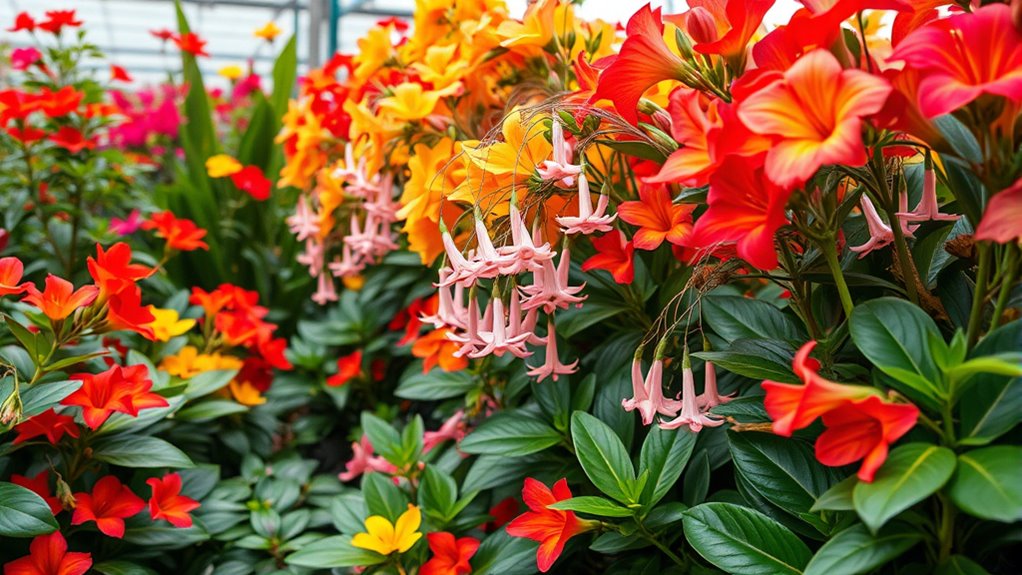
To keep your greenhouse healthy, you need to regularly monitor your plants for signs of pests and diseases.
Using organic control methods can help manage issues without harming your plants or the environment.
Preventive measures, like proper sanitation and airflow, are key to avoiding problems before they start.
Regular Monitoring Practices
Regular monitoring is essential for keeping pests and diseases under control in your greenhouse. By regularly inspecting your plants, you can catch issues early and prevent major outbreaks.
Focus on key areas like soil enrichment, ensuring nutrients support healthy growth, and maintain proper plant spacing to improve airflow.
Here are four tips to enhance your monitoring routine:
- Check leaves and stems for signs of pests or disease.
- Inspect soil surfaces regularly for mold or fungus.
- Look for unusual spots or discoloration on blooms.
- Keep a detailed record of plant health and any problems.
Consistent monitoring helps you identify problems before they spread, allowing quick action. This proactive approach keeps your flowering plants healthy, vibrant, and ready to bloom.
Organic Pest Control Methods
Organic pest control methods offer an effective and environmentally friendly way to manage pests and diseases in your greenhouse. You can use companion planting to deter harmful insects naturally; for example, planting marigolds near your flowering plants can repel nematodes and aphids.
Biological pest control is another powerful tool, involving beneficial insects like ladybugs or predatory mites that naturally hunt pests, reducing the need for chemical interventions. Regularly inspect plants and introduce these beneficial organisms early to prevent infestations.
Combining companion planting with biological pest control creates a balanced ecosystem that keeps pests in check without harming your plants or the environment. These methods are safe, sustainable, and help promote healthy, vibrant blooms in your greenhouse.
Preventive Disease Measures
Implementing preventive disease measures in your greenhouse is key to maintaining healthy, pest-free plants. Start by monitoring regularly for early signs of pathogens and pests.
Strengthen pathogen resistance by maintaining ideal air circulation and humidity levels. Use fungicide application proactively to prevent fungal infections before they spread.
Additionally, sanitize tools and containers to avoid transferring diseases. Finally, rotate crops to minimize the buildup of pathogens in the soil.
These steps help reduce the risk of disease outbreaks and keep your flowering plants vibrant. By staying vigilant and applying these measures consistently, you’ll create an environment where healthy blooms thrive, and pest issues are minimized.
Prevention is your best defense for flourishing greenhouse plants.
Pruning and Deadheading to Promote Continuous Flowering
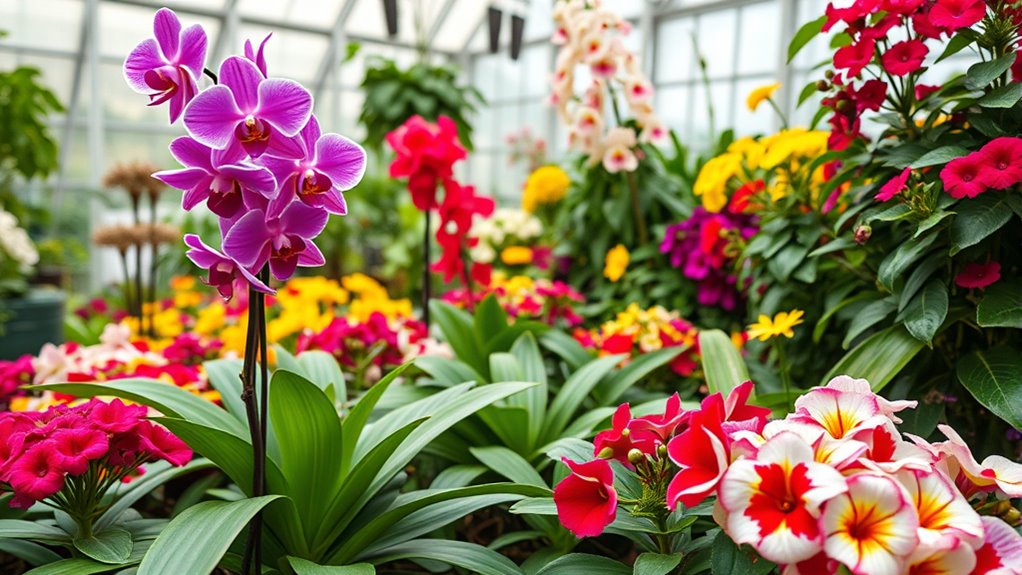
Pruning and deadheading are essential techniques to keep your greenhouse flowers blooming continuously. Regular deadheading methods remove spent blooms, encouraging new ones to form. Adhering to pruning schedules ensures plants stay healthy and promote continuous flowering. Use sharp tools to trim back stems just above leaf nodes, stimulating growth. Here’s a simple guide:
| Deadheading Techniques | Pruning Schedules |
|---|---|
| Remove faded flowers | Weekly for most plants |
| Cut just above leaves | Monthly or as needed |
| Use clean tools | After flowering peak |
Consistent deadheading prevents seed formation, redirecting energy into new blooms. Proper pruning maintains plant shape and encourages more frequent flowering. Keep to your pruning schedules, and you’ll enjoy vibrant, continuous blooms all season.
Managing Pollination and Flower Set
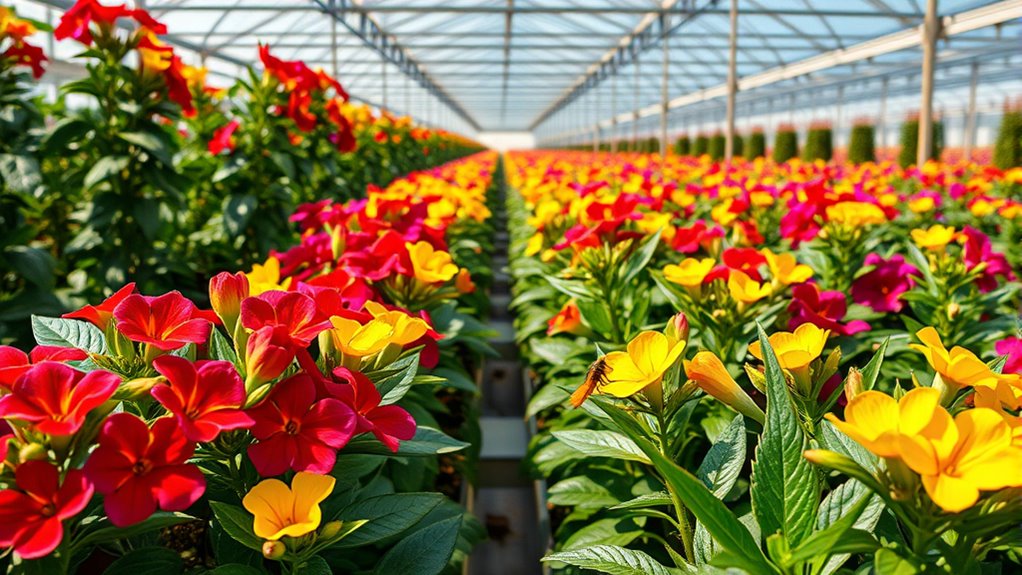
Managing pollination and flower set is essential for ensuring your greenhouse plants produce abundant and healthy blooms. Proper pollination techniques directly influence each flower development stage, from bud to full bloom.
To optimize this process:
- Observe flowers closely during early stages to identify receptive blooms.
- Use hand pollination with a fine brush or cotton swab to transfer pollen effectively.
- Maintain ideal environmental conditions, like proper humidity and airflow, to encourage natural pollination.
- Introduce pollinators, such as bees or bumblebees, if feasible, to enhance natural pollination rates.
Seasonal Adjustments to Maintain Year-Round Blooms
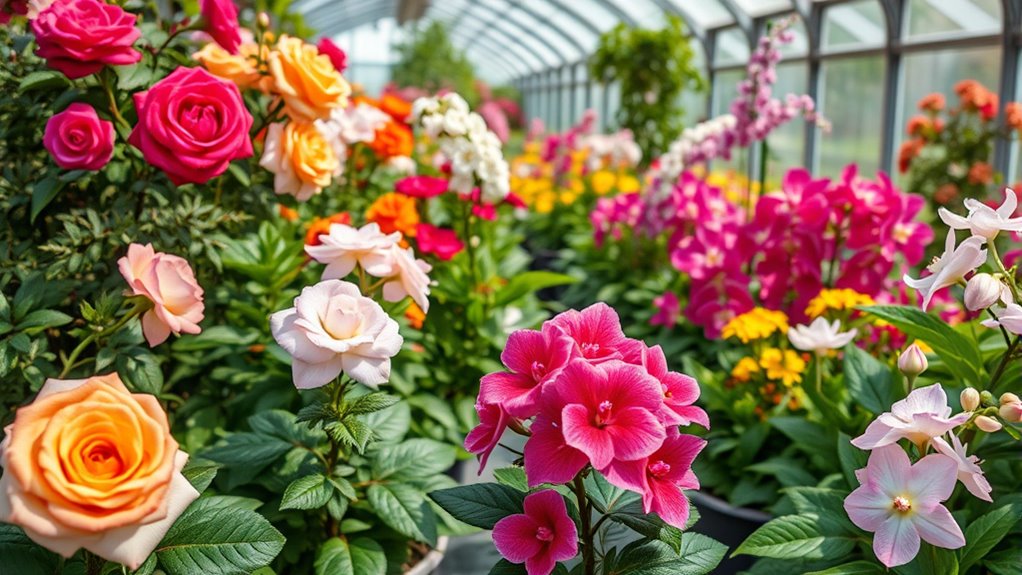
To keep your greenhouse blooms thriving throughout the year, you need to adapt your practices to changing seasons. Seasonal pruning helps shape plants and encourages new growth, which affects bloom timing.
In winter, trim back overgrown stems to stimulate early flowering, while in summer, remove dead or faded blooms to promote continuous blooms.
Adjust your lighting and temperature settings to match seasonal needs, ensuring plants receive the right cues for blooming.
By monitoring bloom timing, you can predict and influence flowering cycles, extending or stimulating blooms when needed.
Consistent pruning and environmental adjustments help maintain a steady display of flowers year-round.
Staying attentive to each plant’s seasonal requirements ensures you enjoy vibrant, healthy blooms regardless of the time of year.
Frequently Asked Questions
How Do I Select the Best Flowering Plants for Limited Greenhouse Space?
When choosing flowering plants for limited greenhouse space, focus on effective plant selection and space optimization.
Opt for compact varieties or those with vertical growth habits to maximize your area. Use tiered shelving or hanging baskets to create more room.
Prioritize plants that thrive in your climate and lighting conditions.
What Are Common Mistakes in Greenhouse Flower Care to Avoid?
Don’t let small mistakes trip you up; they can turn your green thumb into a thorny mess. Common errors include watering too much or too little, which harms roots, and improper pruning, which stunts growth.
Always monitor moisture levels and prune selectively to promote healthy blooms. Staying attentive and avoiding these pitfalls guarantees your plants thrive, turning your greenhouse into a vibrant oasis instead of a wilted, struggling space.
How Can I Extend the Blooming Period of My Greenhouse Plants?
To extend your greenhouse plants’ blooming period, you should optimize lighting control by providing consistent, appropriate light hours to prevent premature flowering.
Additionally, adjust fertilizer scheduling by using a balanced, bloom-boosting fertilizer to support prolonged flowering.
Keep temperatures stable, prune dead blooms regularly, and monitor humidity.
These steps help your plants stay healthy and bloom longer, giving you vibrant, extended displays throughout the season.
Are There Eco-Friendly Practices for Greenhouse Flower Maintenance?
Imagine nurturing vibrant blooms while caring for the planet. You can adopt eco-friendly practices like composting methods to recycle plant waste and enrich your soil naturally.
Additionally, water conservation becomes effortless with drip irrigation and rainwater harvesting, reducing waste and supporting sustainable gardening.
These methods not only maintain healthy greenhouse flowers but also minimize your environmental footprint, allowing you to enjoy beautiful blooms responsibly and sustainably.
How Do I Troubleshoot Unexpected Flowering Problems in My Greenhouse?
When troubleshooting unexpected flowering problems, start by checking your pest management strategies, as pests can hinder blooms.
Confirm your soil preparation is proper, with adequate nutrients and appropriate pH levels, to promote healthy flowering.
Inspect plants regularly for signs of stress or disease, and adjust watering or lighting as needed.
Conclusion
With the right tips, you can transform your greenhouse into a vibrant oasis of color and life. Imagine a lush paradise where blooms burst in every corner, their petals shimmering under perfect light, and their fragrances filling the air. By carefully selecting plants, managing conditions, and nurturing each flower, you’ll create a stunning display that delights the senses year-round. Keep tending your greenhouse with passion, and watch your garden of dreams flourish into a breathtaking floral haven.
